
GIVEN THE DISMAL situation of the world’s fisheries and oceans from overfishing and overconsumption of seafood, we strongly request that you refer to the various sustainable seafood websites before purchasing fish and shellfish. Before we use any seafood, we ask where it came from, how it was caught and whether it is in abundant supply and not threatened. It’s very simple to know which seafood is okay to eat and which is not: just type “sustainable seafood guide” or “sustainable seafood choices” in your Internet search engine, and you will get various reputable websites from Blue Ocean Institute, Environmental Defense Fund, Monterey Bay Aquarium, Marine Stewardship Council, SeaChoice, Ocean Wise, and so on.
Since we’re based in Vancouver, British Columbia, we cook a lot with B.C. sablefish and spot prawns and have included some recipes in this book because we know they’re responsibly managed, sustainable seafood. If you don’t have access to trap-caught spot prawns or California-farmed prawns, don’t buy imported farmed or wild prawns, as they come from countries with very few environmental regulations. Warm-water shrimp farms are very crowded, depend on antibiotics and other chemicals to maintain “disease-free” populations or frequently have high levels of fecal content in their water. The farms often release these chemicals and waste products into already sensitive coastal environments.
Wild-caught imported prawns are fished by bottom trawling, which involves dragging a large weighted net behind a boat to catch the shrimp that are churned up from the ocean bottom. Unfortunately, lots of other fish and shellfish, along with already endangered sea turtles, are unnecessarily caught and killed when they get swept up in the nets.
Not only is eating the wrong seafood harmful to our environment, but increasingly it’s harmful to our personal health, too—we hear warnings of mercury levels in the news more often now. Most sustainable seafood guides point out these health factors as well. In the end it really isn’t that difficult to identify which seafood is good to eat—from both environmental and personal health perspectives. The organizations mentioned above list and continually update information on their websites about which seafood is fine for consumption, and you can even download these lists on wallet-size cards to take shopping with you. Many restaurants, grocery stores and seafood vendors are also becoming aware of these issues. Armed with good sources of information and conscientious sellers, most likely you’ll find the right seafood choice and help spread the word about sustainable seafood.
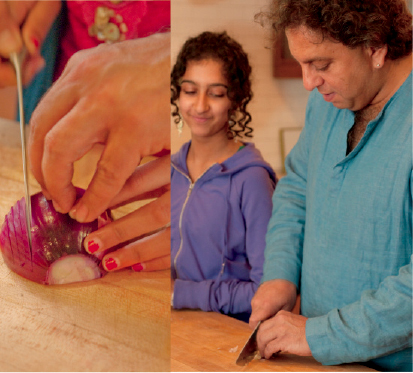
Spicy Roasted Crickets
Crickets are members of the same family as prawns. We don’t expect that many people will actually source crickets and make this dish, but putting crickets on our menu at Vij’s led to one of the most interesting years of our professional lives. For one year, we offered a parantha (flatbread) made from spiced, roasted and ground crickets. The flatbread recipe is complicated and very time consuming, but this recipe is much easier. It’s as simple as roasting almonds or cashews, and you can eat these spiced, roasted crickets just as you would eat spiced nuts.
Before we got started, and to learn more about eating bugs, we invited David George Gordon, a bug cookbook author, biologist and entomophagist (someone who studies the value of eating insects) to meet us for dinner in Vancouver. He drove up from Seattle with a mind full of facts and a cooler full of bugs, and his enthusiasm for promoting insects as food was intimidating, intoxicating and rational. He also confirmed that, until specialty food stores sell edible insects along with other gourmet products, the best place to buy a small quantity of them is the pet store. (David buys all of his insects from Fluker Farms in Louisiana—they provide shipping.) Look for four-week-old crickets, as the six-week-old ones are quite large.
We needed quite a lot of crickets to make our paranthas, so we located Reeves Cricket Ranch in Everson, Washington. We discovered that the crickets were raised on an apple feed (if you’re concerned, many pet stores write down what the bugs are fed), and we had our crickets tested by the Vancouver health department to be sure they were absolutely fine for human consumption.
When Meeru first made this cricket recipe, Vikram’s sister and her two young sons were visiting from Singapore. The boys embraced the idea of eating bugs but were surprised that they tasted good. At first Nanaki and Shanik refused to try them. Shanik was in the third grade at the time, and a boy in her class was teasing and chasing her. When she realized that she could impress this boy (and scare him as well) by eating crickets, she gave them a try and took some to school. Many of our customers were both shocked and curious about our decision to put crickets on the menu, and Vikram thoroughly enjoyed the look on their faces—before ordering the crickets and after having eaten them. The insect paranthas were very popular.
If you decide to make this dish, you can buy the live crickets from your local pet store and put them in your freezer. Apparently, this is the most painless way for the insects to die. (It’s much easier and cleaner even than trimming fat off of beef, lamb, chicken.) For an extra protein and iron boost, roast the crickets without the salt or spices, grind them in a spice (or coffee) grinder and add them to bread, cookie and muffin recipes.
Be sure to use only fresh crickets and store them carefully. Do not eat raw crickets (just as you would never eat uncooked poultry), and try to consume roasted ones within the day. If you do have some roasted crickets or roasted and ground crickets left over, they will keep refrigerated in an airtight container for a day or two.
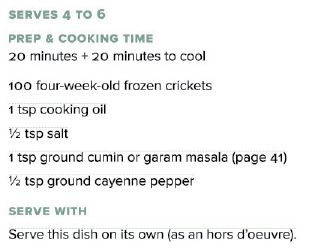
Preheat the oven to 350°F.
Spread crickets on a baking sheet, sprinkle with oil, salt, cumin (or garam masala) and cayenne, and toss until thoroughly mixed. Bake for 15 minutes, stirring once halfway through, or until darker, crunchy and dry but not black and burned. Roast them for another 5 minutes, if necessary. Allow to cool for 20 minutes, then serve within a few hours.
Steamed Sablefish
In this recipe, you can use as many or as few spices as you choose, but be sure to use the oil and salt. Sablefish has a strong flavour, so it can easily stand on its own. We prefer to eat sablefish with the skin on.
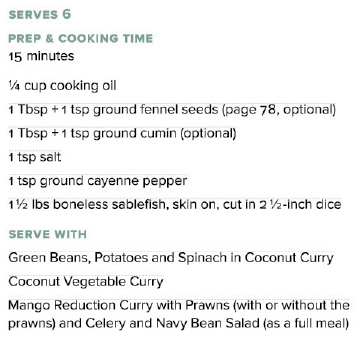
In a large bowl, combine oil with fennel seeds, cumin, salt and cayenne. Add sablefish and mix gently. (You don’t need to marinate this fish because it’s such a buttery, strong-flavoured fish that too much marinating actually takes away from its flavour.)
Bring water to a boil in a large double boiler with a steamer insert on high heat. (If you don’t have a double boiler, try setting a metal colander inside a large pot with a lid. Fill the pot with about 1 inch of water; the water should not touch the fish.) Place sablefish in the top part of the double boiler, ensuring that the fish pieces do not overlap. (Steam sablefish in two or three batches, if necessary, to prevent overcrowding). Cover and steam sablefish for 5 minutes, or until fish flakes easily when gently poked with a knife. Remove from the heat.
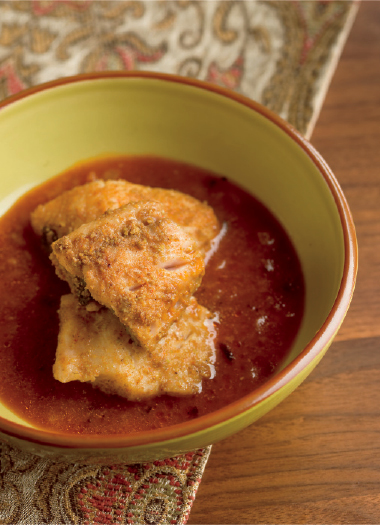
Mango Reduction Curry
with Prawns
Sometimes, finding a new recipe to replace an already popular and delicious one on the menu can be very frustrating. If the new recipe isn’t as good or better than the old one, then our regular customers let us know. Sital, Amarjeet and Meeru had spent many unsuccessful afternoons trying to come up with a new seafood recipe. After using every spice they could think of, Meeru joked out of frustration, “Just toss some fish in a bowl of mango juice, since that’s the only thing left.” Sure enough, we threw in some prawns and this recipe was born. At Vij’s, we have served this mango reduction with B.C. halibut, B.C. sablefish and California-farmed prawns or local B.C. spot prawns, so choose whichever seafood you prefer.
Although it has a fresh and crisp flavour, this curry is nevertheless quite rich. In this recipe, be sure to use yellow mustard seeds and not the black ones. The flavour of almost-burned sautéed onions is also important. Because mango juice is sweet, we have used more cayenne than usual; however, if you wish you can cut this amount in half. Finally, we use a thick mango juice rather than a watery kind—usually the Indian or South African brands of mango juices work best.
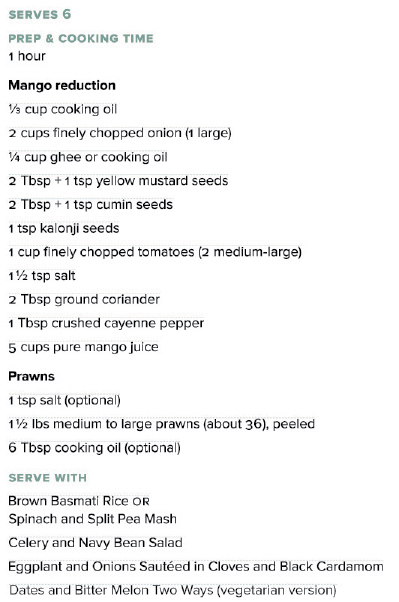
Mango reduction Heat oil in a large, heavy-bottomed pan on high for 1 minute. Add onions and sauté, stirring regularly, for 5 to 8 minutes, or until dark brown. Remove from the heat and set aside.
Heat the 1/4 cup ghee (or oil) in a medium pot on medium-high for 45 seconds. Add mustard, cumin and kalonji seeds all at once and heat them, stirring constantly, for 1 to 2 minutes, or until you hear the first few popping sounds. (The stirring will make a squeaky noise.) Add tomatoes and stir to combine. Add salt, coriander and cayenne and cook, continuing to stir well, for another 4 to 5 minutes, or until ghee (or oil) is glistening. Add mango juice and bring the mixture to a boil. Reduce the heat to medium and allow it to boil gently, uncovered, for 5 minutes until the ghee (or oil) once again glistens on top.
Balance a fine-mesh sieve or a strainer with handles over the pan of sautéed onions. Be sure that it’s well balanced and sturdy. Carefully pour mango reduction curry into the sieve (or strainer) and allow it to drain into the onions. Using a large ladle or a cooking spoon, press tomatoes and spices to extract as much liquid and flavour as possible, then discard the solids.
Prawns To make crispy prawns, rub salt gently all over prawns. In a large frying pan or wok, heat oil on medium-high for 45 seconds. Add prawns, stirring and sautéing for about 4 minutes, or until they are just pinkish-orange all over. Be sure not to overcook the prawns. You can either put cooked prawns in the curry or place the prawns in a dish and pour hot curry overtop to serve.
Alternatively, if you prefer not to use any oil, simply add prawns (with or without the salt) to the simmering mango reduction and cook for about 4 minutes, or until they are pink. Again, be sure not to overcook the prawns.
Prawns in Pomegranate Curry
Our brother-in-law, Gregg, made this recipe on his mini-stove in New York City. He banished us all from the kitchen, then emerged twenty-five minutes later with the finished dish. When we sat down to taste his curry, we all agreed that it wasn’t very good at all, and all eyes were on Meeru’s faulty recipe. But the recipe was fine.
Most of the recipes in this book are very forgiving, but this one has very few ingredients, so each one counts. Following Meeru’s cardinal rule that nothing (for the most part) in Indian cooking is carved in stone, Gregg had chopped three onions into large pieces and cooked them according to this recipe. The result was a weak, sweet masala. To obtain the desired robust, browned onion flavour and thick-textured masala, it’s crucial that you finely chop the onions in this recipe. If you insist on chopping the onions in large pieces, then you will have to double or triple your sautéing time.
You can vary the juice in this recipe, if you like. The pomegranate juice will have more of a zing (which we prefer), and mango juice will make the dish slightly sweeter. If you have any leftover juice, add shots of vodka and ice to it and drink as an aperitif to set a festive mood for dinner. Serve with slices of baguette or bowls of rice.
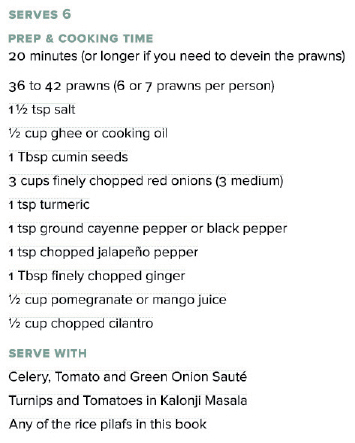
Peel prawns and devein them, if required. Gently rub prawns with 1/2 tsp of the salt, place them in a bowl and refrigerate them if you’re not going to cook them right away.
In a large frying pan, heat ghee (or oil) on medium-high for 1 minute. Sprinkle in cumin seeds and allow them to sizzle for 45 seconds. Add onions and sauté for 8 minutes, or until golden brown with darker edges. Reduce the heat to medium and add turmeric, the remaining 1 tsp of salt and cayenne (or black pepper). Stir, sauté for 1 minute, then add jalapeño pepper and ginger and sauté for 1 minute more.
Add pomegranate (or mango) juice and bring it to a boil, which will take less than 30 seconds. Add prawns and stir gently. Sauté prawns—still stirring gently—for about 4 minutes, or until orange-pink and firm when poked with a spoon. Remove from the heat and stir in cilantro.
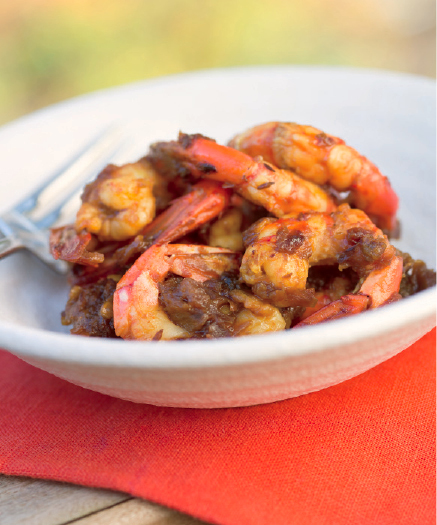
Tilapia
in Yogurt and Ginger Curry
Yogurt can be a good alternative to onions and garlic. We don’t mean that they are similar in flavour, but yogurt is bold enough to carry a curry without the aid of onions and garlic. So, make this dish if you don’t like onions or garlic or if you want a change from regular onion-based curries. You can just as easily add sautéed onions or garlic to this dish if you like, or not use ginger at all. This curry is a lighter version of Yogurt Curry.
At Rangoli, we serve variations of this curry with spiced, breaded and seared tilapia. You could use any white fish, but please make sure that the fish comes from a sustainable farm and that, if it’s wild, it isn’t an endangered or threatened fish. Buy the fillets boned, trimmed and scaled, or, if you prefer, buy the entire fish and prepare it yourself at home. If you’re a vegetarian, you can serve just the curry as a soup with rice on the side. You can also sauté your favourite vegetables in some oil with salt and mix them with the rice and curry.
We always serve this dish with white basmati rice in a large bowl.
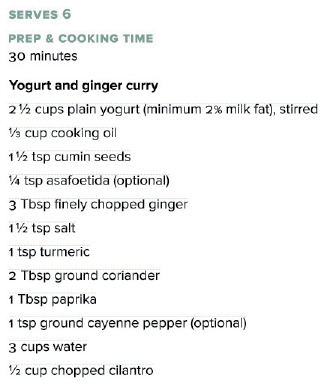

Yogurt and ginger curry Place yogurt in a large bowl and set aside.
In a medium pot, heat oil on medium for 1 minute. Add cumin seeds and allow them to sizzle for 30 to 45 seconds, or until darker brown. Stir in asafoetida. It will sizzle within 30 to 45 seconds and darken, which means it is cooked. Add ginger, stir and sauté for 1 minute. Add salt, turmeric, coriander, paprika and cayenne and stir for 2 to 3 minutes. The spices will become slightly pasty. Turn off the heat and stir in water.
To prevent the yogurt from curdling, whisk 1 cup of the masala-water mixture into the yogurt. Pour the yogurt into the pot of masala-water and stir well with a whisk. Turn the heat to high and bring curry to a boil, whisking constantly, then reduce the heat to medium-low and simmer for 5 minutes, stirring once or twice. Set aside while you prepare the fish.
Pan-seared breaded tilapia If necessary, trim whole fillets by placing them on a cutting board and, using a large knife, cutting off and discarding the skimpy, whitish edges that are mostly skin (about 1/4 inch each side). Scrape any fish scales off the skin and discard them (there shouldn’t be too many on tilapia). And, if necessary, cut each fillet lengthwise down the middle and check for bones. You can usually cut them out quite easily by slicing a lengthwise V into the bones and pulling them out. You can also feel with your hands to see if there are any bones or scales still on the fish and pull out with your hands any that are left over. Wash the fillets and set them aside in a colander to dry for a few minutes. You should have a total of 12 small fillets.
In a large bowl, combine bread crumbs, cayenne, salt, coriander, turmeric, black pepper, paprika and asafoetida. Add tilapia fillets and mix carefully until fish is coated with the spiced bread crumbs.
Heat 1 tsp oil in a heavy-bottomed frying pan on medium for 1 minute. Place 2 fillets, skin side down, in the frying pan and cook for about 2 minutes. (If the fillets begin to burn or stick to the pan, add a bit more oil.) Gently turn the fish over and cook the second side for 2 minutes, or until flesh flakes when gently poked with a knife. Transfer the cooked fillets to a baking sheet. Add 1 tsp oil to the frying pan, heat for 1 minute, then cook 2 more fillets. Repeat with the remaining fillets.
Finish curry Heat curry on high and bring to a boil, stirring 2 to 3 times. Stir in cilantro and serve piping hot over tilapia fillets.
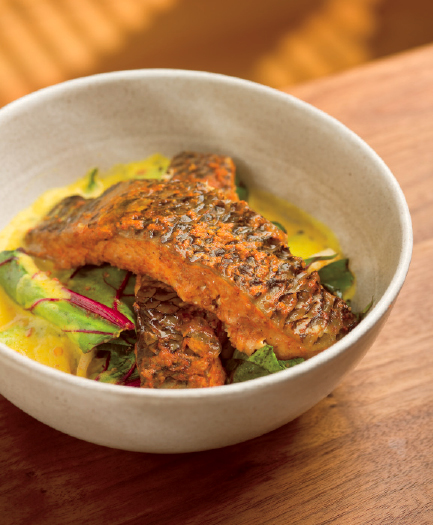
shown here with Beet Greens Sautéed in Ginger, Lemon and Cumin
Steamed Marinated Halibut
Often we visit our friends Victoria and Oleg’s home for Ukrainian dinner, and Victoria serves us steamed crab and other fish with various dressings made from mayonnaise, horseradish and garlic. Luckily, we really enjoy Victoria and Oleg’s company, so we don’t have to pretend to be their friends just to eat their delicious Ukrainian food.
This is our Indian version of Victoria’s steamed fish, using local halibut with our sour cream Indian dressing. We recommend that you serve this dish with the sour cream dressing or even just mayonnaise, but if you choose not to, we suggest a squeeze of lemon on the steamed halibut.
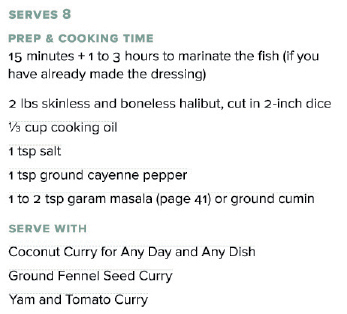
Combine halibut, oil, salt, cayenne and garam masala (or cumin) in a large bowl. Toss lightly to coat the fish, then cover and refrigerate for 1 to 3 hours to allow halibut to marinate.
Bring water to a boil in a large double boiler with a steamer insert on high heat. (If you don’t have a double boiler, try setting a metal colander inside a large pot with a lid. Fill the pot with about 1 inch of water; the water should not touch the fish.) Place halibut in the top part of the double boiler, ensuring that the fish pieces do not overlap. (Steam halibut in two or three batches, if necessary, to prevent overcrowding). Cover, reduce the heat to medium-high and steam halibut for 4 minutes, or until fish flakes easily when gently poked with a knife. Remove from the heat.
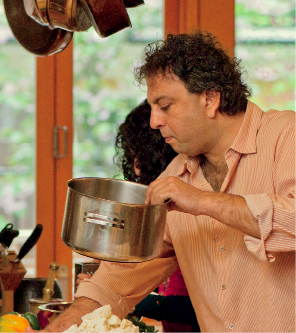
Steamed Marinated Halibut
in Black Chickpea, Potato and Coconut Curry
We love the combination of halibut and black chickpeas and will most likely keep coming up with different recipes based on these two ingredients. In this recipe we combine a steamed halibut with a rich curry. To bring out the flavours of garlic and ginger, we chop the onion as finely as the garlic so that it’s less dominant. We also use the usual curry spices in this dish, but with one rare omission—turmeric. This combination of ingredients just doesn’t need it. Finally, we marinate the halibut in any oil but olive, as olive oil has a stronger flavour than many other oils. This is a full-on recipe that will take you time to prepare, so try not to skip out on any of the ingredients, except for adjusting the salt and cayenne to your taste.
Punjabi food folklore has it that the water from soaking black chickpeas is full of health benefits and should always be used for cooking. Our moms still do this, as their moms and many generations of moms did before them. We follow this tradition, even at our restaurants, by using this reserved soaking water in our curries. Having said that, it is not essential that you follow this tradition.
We prefer to steam the halibut in this dish in a double boiler for a few minutes rather than searing it, as the extra oil needed for searing adds weight to this dish, and the potato-coconut curry is already quite rich. If you don’t have a double boiler, try setting a metal colander inside a large pot with a lid. Be sure not to add too much water to the pot; you want to steam the fish, not boil it.
Even though this is a complicated recipe, serve it simply with rice, a green salad, or carrot sticks and cucumber rounds on the side.
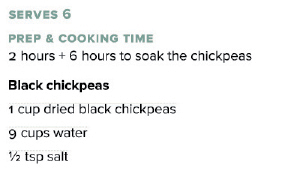
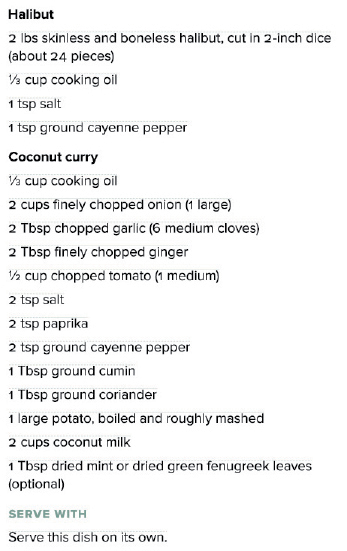
Black chickpeas Wash and drain the chickpeas twice in cold water. Place chickpeas and 3 cups of the water in a medium bowl. Set aside and allow to soak for at least 6 hours or up to 10 hours. (To save time soaking and boiling, you can cook the chickpeas and 6 cups water in a pressure cooker for 23 to 25 minutes.)
Drain the soaking water into a clean pot. Reserve this water for the curry.
Combine chickpeas and the remaining 6 cups of water in a medium pot on high heat. Add salt and bring to a boil, then reduce the heat to low, cover and simmer for 40 to 50 minutes. (Taste a chickpea to see if it is cooked.)
Turn off the heat. You should have approximately 4 cups of water left in the pot of chickpeas. If you don’t have enough, add some of the reserved chickpea soaking water to make 4 cups.
Halibut While the chickpeas are cooking, gently combine halibut, oil, salt and cayenne in a medium bowl. Cover and refrigerate while you make the curry. (You can also marinate the halibut up to 24 hours in advance and keep it, covered, in the refrigerator.)
Coconut curry Heat oil in a medium-large pot on medium-high for 1 minute. Add onion and sauté for 4 minutes, then add garlic and sauté for 1 minute. Stir in ginger, tomato, salt, paprika, cayenne, cumin and coriander and sauté for 4 to 5 minutes, or until spices become a bit pasty and stick slightly to the bottom of the pot. Stir in potato, coconut milk and cooked chickpeas and their water. Reduce the heat to medium-low, cover and cook while you steam the halibut. In the final few minutes, stir in mint (or fenugreek).
Finish halibut Bring water to a boil in the bottom of a double boiler. Loosely arrange halibut in a single layer in the top of the double boiler (you may need to steam the fish in two or three batches). Set the top of the double boiler over the boiling water, cover and steam for 4 minutes. Remove the cover and gently poke one piece of fish gently with a knife to see if it flakes easily. The fish should be white but not hard to the touch. Steam halibut another minute or two, if necessary. Transfer cooked fillets to a plate. Repeat with the remaining halibut.
Place the halibut in a bowl and top it with piping hot curry.
Grilled Marinated Wild Salmon
in Green Onion, Coconut and Ginger Broth
We recommend you use wild salmon to make this recipe because, unlike the enclosed farms used to raise other fish, salmon farms are coastal, and many marine environmental groups and scientists have questioned the farming practices as well as the impact salmon farms have on the oceans. Given the shape of the fish, it may be difficult to cut equal-sized pieces of salmon, but try to keep them similar enough that they cook in the same amount of time.
The broth in this recipe is lighter and more mildly spiced than most curries—in fact the flavour of the ghee stands out, since we don’t use many other spices. We based the measurement for the jalapeño pepper on a medium-spicy pepper, but adjust the amount based on your preference and the strength of your pepper. To test its heat, cut open the pepper, tap it with your finger and then lick your finger. If it is a very spicy pepper, you will taste it right away and you can reduce the amount to one tablespoon.
In addition to serving this broth with the salmon, you can also serve it like a soup on its own (with just a piece of baguette).
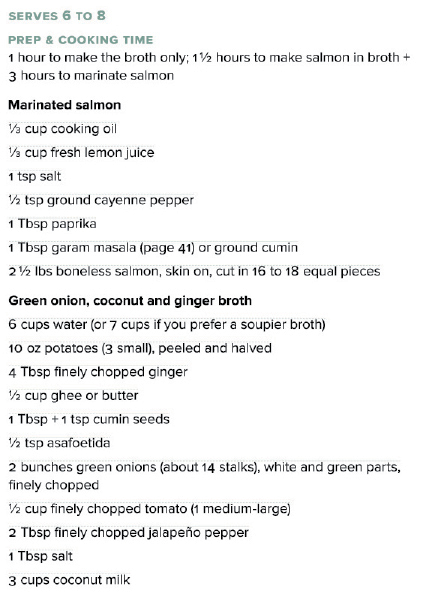
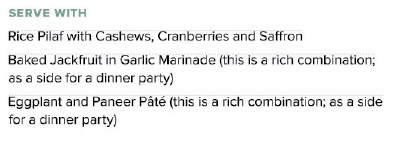
Marinated salmon In a large bowl, combine oil, lemon juice, salt, cayenne, paprika and garam masala (or cumin) until well mixed. Add salmon and stir gently until fish is well coated with the spice mixture. Cover with plastic wrap and refrigerate for 3 hours.
Green onion, coconut and ginger broth In a large pot, combine water, potatoes and ginger and bring to a boil on high heat. Reduce the heat to low, cover and boil for 30 to 45 minutes, or until potatoes are cooked. Turn off the heat and set aside (do not drain potatoes).
In a heavy-bottomed pan, heat ghee (or butter) on medium-high for 1 minute. Sprinkle in cumin seeds and allow to sizzle for about 15 seconds. Sprinkle in asafoetida and cook for 15 seconds more. Add green onions and sauté for 5 to 6 minutes, or until dark brown but not burned. Stir in tomato, jalapeño pepper and salt and cook for 4 to 5 minutes, or until ghee starts to glisten. Turn off the heat and set aside.
Transfer potatoes from the pot to a large bowl, reserving the ginger broth, and mash until smooth (you can add a bit of ginger broth, but do not add any milk). Stir mashed potatoes into the green onion and tomato masala. Using a large ladle, spoon ginger broth into the masala, stir well, then add coconut milk. Stir again and turn heat to medium-high and bring to a boil. Reduce the heat to low and boil gently, stirring regularly, for 10 minutes, or until ghee glistens on top.
Finish salmon Heat a barbecue or stovetop grill to high. Place 3 pieces of salmon on the grill. Using tongs, turn salmon each minute for a total of 5 to 6 minutes, or until fish flakes easily when gently poked with a knife. Transfer cooked salmon pieces to a clean plate. Repeat with the remaining salmon, until all pieces are cooked. Serve salmon in bowls with 1 to 1 1/2 cups of broth per person.
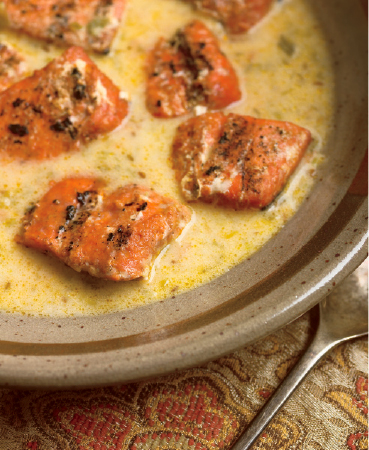
Dungeness Crab Spoons
with Coconut, Cilantro and Jalapeño Peppers
This dish is one of Vikram’s most elegant recipes. It combines a myriad of spices that offer a gentle yet exotic hint of flavour. You don’t have to use all of them, but to make the most of the Dungeness crab, do try to use whichever ones you can. You will need a two-foot square of cheesecloth or another similar type of muslin cloth to infuse the crab. Keep a little extra jalapeño pepper, lemon and cilantro on hand, in case you want to add a bit more after you’ve mixed all the ingredients together.
At Vij’s we serve this crab mixture on various large soup spoons, using one tablespoon per serving. You don’t have to be exact in your measurements, though, since it’s easy to eat more than one spoon per person. Soup spoons that can sit on their own are perfect for this recipe.
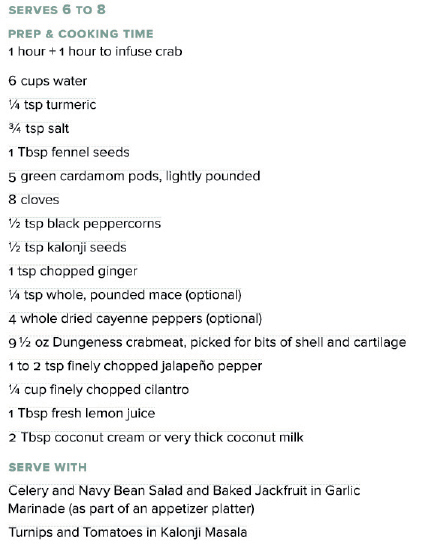
In a medium pot, combine water, turmeric, 1/2 tsp of the salt, fennel seeds, cardamom, cloves, peppercorns, kalonji, ginger, mace and cayenne. Bring to a boil on high heat and then reduce to medium. Cover and boil for at least 20 minutes or up to 1/2 hour for a stronger flavour. Turn off the heat and allow the stock to cool until it is just warm to the touch.
While the stock is cooling, arrange the cheesecloth (or muslin) on a clean work surface. Grasp the left-hand edge of the cheesecloth and fold it one-third of the way over the rest of the cheesecloth. Repeat with the right-hand edge of the cheesecloth to create a piece of cheesecloth that is three layers thick. Place crabmeat in the cheesecloth, gather the four corners and tie them together with a piece of kitchen string so that no crabmeat can escape.
Set a large sieve over a medium bowl or a clean pot. Gently strain the stock through the sieve and discard the solids. Place the crabmeat sachet into the stock and allow it to infuse for 1 hour.
Remove the sachet from the stock and squeeze it gently to remove any excess water. Carefully untie the sachet. In a medium bowl, combine crabmeat, jalapeño pepper, the remaining 1/4 tsp of salt, cilantro, lemon juice and coconut cream (or coconut milk). Taste the mixture and adjust the seasoning until you have mild flavours of coconut, cilantro, lemon and peppers. Cover and refrigerate the crab mixture until just before serving. Will keep refrigerated for up to 3 days.
To serve, arrange twelve to fourteen soup spoons on a serving platter. Drop one tablespoonful of the crab mixture into each soup spoon.

shown here with Quinoa Salad with Lentil Sprouts